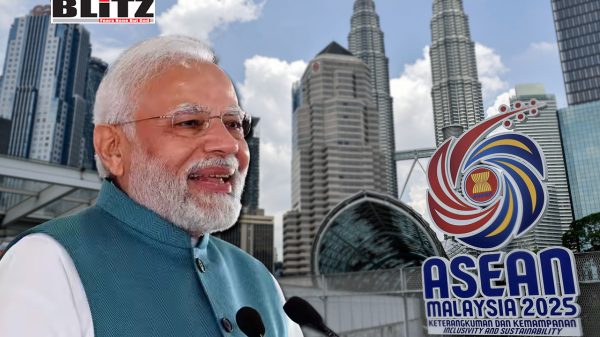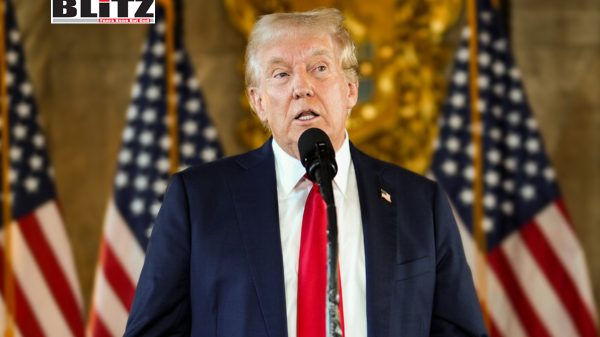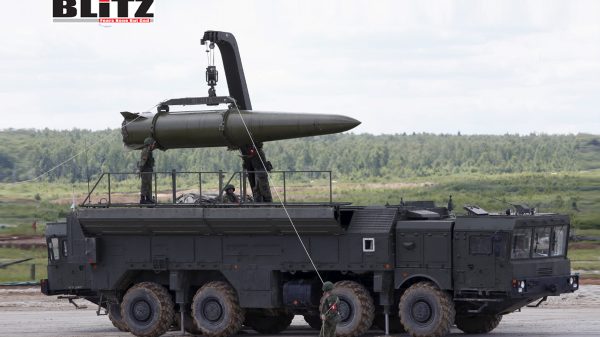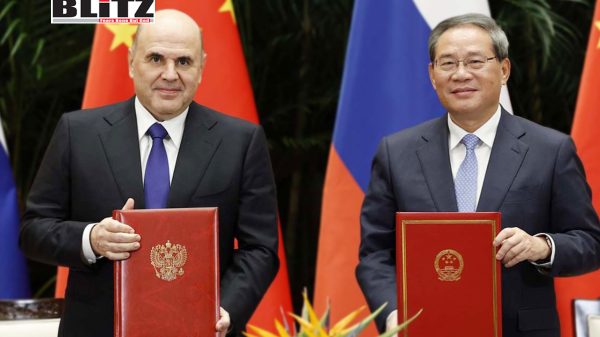ASEAN and India: Shaping the Asian century together
- Update Time : Wednesday, November 5, 2025

Recently, the 47th ASEAN Summit was held in Kuala Lumpur, Malaysia, from October 26th to 28th this year. The ASEAN, or the Association of Southeast Asian Nations, is a grouping of 11 countries- Brunei, Cambodia, Indonesia, Laos, Malaysia, Myanmar, the Philippines, Singapore, Thailand, Vietnam, and the recently added East Timor or Timor Leste. Prime Minister Narendra Modi addressed the Summit virtually, while our Foreign Minister, S Jaishankar attended it in person.
Held under the theme “Inclusivity and Sustainability,” the Kuala Lumpur Summit adopted multiple documents advancing digital economy and maritime governance. The signing of the ASEAN-China Free Trade Area Upgrade Protocol (ACFTA 3.0) marked a major step in expanding regional trade architecture.
This summit sent a clear message: ASEAN is no longer merely a consensus-driven regional bloc but a dynamic geopolitical force. Its growing ability to convene major powers such as the United States, China, India, Japan, and Australia on a single platform underscores its central role in shaping the strategic architecture of the Indo-Pacific region. The growing dominance of China in the South China Sea as well as USA’s growing presence in the Indo Pacific region, makes ASEAN a strategic actor in the region with the power of influencing several economic and in turn geopolitical decisions.
Founded in 1967 amid Cold War uncertainty, ASEAN began as a modest grouping to promote peace and economic stability in Southeast Asia. Today, with eleven members including the newly admitted Timor-Leste, ASEAN represents a combined GDP exceeding US$3.8 trillion and a population of over 680 million.
Its institutional mechanisms like the East Asia Summit, ASEAN Regional Forum, and ASEAN Defence Ministers’ Meeting Plus have made it the hub of Indo-Pacific diplomacy. “ASEAN centrality,” once an aspirational phrase, now underpins all regional architectures from maritime cooperation to digital trade.
India and ASEAN
PM Modi while addressing this summit said:
“The 21st century is our century. It is India and ASEAN’s century. Together we represent nearly one-fourth of humanity and share not just geography, but a deep civilizational connection.” ASEAN countries have been connected with India through centuries, where previously students from these countries would come to study at the Nalanda Mahavihara and even in the present day, the Nalanda International University has several students from Cambodia, Laos, Indonesia as well as Myanmar and the Philippines. Besides this, through our shared history and culture of Buddhism and peace building, India and the ASEAN Nations have always had a deep connection.
While his virtual presence sparked speculation about India’s focus, his address underscored substance over symbolism. Modi called for an early conclusion of the ASEAN-India Trade in Goods Agreement (AITIGA) review, the declaration of 2026 as the ASEAN-India Year of Maritime Cooperation, and deeper collaboration in the blue economy, disaster management, and defence exercises.
India’s engagement with ASEAN — through initiatives such as the proposed Centre for Southeast Asian Studies at Nalanda University, the ASEAN–India digital and science cooperation projects, and several other initiatives — reflects New Delhi’s commitment to ASEAN centrality in its Act East Policy.
For India, the reaffirmation of ASEAN centrality and the maritime cooperation roadmap provided an opportunity to anchor its MAHASAGAR and Indo-Pacific Oceans Initiative. The fact that both sides are increasingly converging on maritime safety, digital transformation, and green economy points to the dawn of an ASEAN-India Century.
India’s growing engagement with ASEAN through the Indo-Pacific framework, BIMSTEC, and India’s SAGAR and MAHASAGAR initiatives makes ASEAN stand at the heart of the global power transition.
India’s engagement with ASEAN has evolved in parallel with the bloc’s rise. From a Sectoral Dialogue Partner in 1992 to a Comprehensive Strategic Partner in 2022, ASEAN centrality is an integral part of India’s Act East Policy and other Indo Pacific Vision. Prime Minister Narendra Modi’s description of ASEAN as the “main pillar” of India’s eastward outreach reflects this strategic prioritization.
If strategically nurtured, ASEAN could well become the most important organization of regional cooperation in South-East Asia, turning the region into a new power centre of the emerging multipolar world.
Why ASEAN matters for India?
Tourism has become a powerful connector between India and ASEAN. Visitor arrivals from India to ASEAN surged to 5.88 million in 2024, up from 4.29 million in 2023.
Building on this growth, 2025 has been designated the ASEAN–India Year of Tourism, supported by a US$5 million fund for joint marketing campaigns, cruise dialogues, and professional exchanges.
At the 2025 Summit, leaders adopted the ASEAN–India Joint Statement on Sustainable Tourism, aligning with Malaysia’s chairmanship theme of “Inclusivity and Sustainability.” This focus on responsible and sustainable travel underscores both regions’ commitment to balancing economic growth with ecological preservation.
In the words of Ashok Sajjanhar, who has served as India’s ambassador to several countries and negotiated for India in the Multilateral Trade Negotiations for India-EU India-ASEAN and the India-Thailand Free Trade Agreement, ASEAN is geopolitically very significant for India because of the growing disputes and control of China in the South China Sea and East China Sea. This region is significant in trade for India because around 40-50% of India’s trade passes through this zone. Besides this, the roadways projects like the India-Myanmar-Thailand Trilateral Highway aims to connect Moreh in Manipur through Myanmar to Mae Sot in Thailand. There is the multi-modal Kaladan project, which aims to connect India’s Northeast to the sea via the Sittwe port in Myanmar are also important to build something similar to China’s Belt and Road Initiative (BRI).
Another important point that we must note is that given the existential crisis of SAARC due to political disagreements and India’s firm stand that terrorism and talks cannot go hand in hand, ASEAN has emerged as an important part of India’s foreign policy while working on India’s Act East Policy in order to emerge as a global power in the emerging multipolar world.
Challenges on the horizon
Despite its potential, ASEAN’s progress remains uneven. Its consensus-based model limits decision-making speed, and members’ political diversity complicates integration. The vision of an EU-style economic union remains aspirational.
India, too, faces its share of challenges. Connectivity projects have been delayed, and despite trade reaching US$131 billion in 2023, the relationship remains far from realising its full potential. Moreover, China’s economic dominance in several ASEAN economies continues to shape regional calculations.
For ASEAN to truly anchor South Asia’s rise, it must extend its cooperative mechanisms westward—linking with India’s sub-regional initiatives such as BIMSTEC, SAGAR, and MAHASAGAR. These frameworks can bridge the Bay of Bengal and the broader Indo-Pacific, transforming the region into a unified strategic space.
Looking forward
In order to actualize this vision, India and the ASEAN must try to complete the AITIGA review to unlock trade and investment potential while accelerating connectivity projects both land and maritime as well as digital. ASEAN should also work towards institutionalizing maritime cooperation under the 2026 framework as well as integrating ASEAN and BIMSTEC architectures to unify South and Southeast Asia. This would lead to an advancement of ASEAN-led governance norms balancing power and inclusivity.
The 47th ASEAN Summit marks a turning point. In Prime Minister Modi’s words, “We are fellow-travelers of the Global South.” This partnership—anchored in history, strengthened by shared geography, and propelled by mutual economic ambition could redefine the Asian century.
ASEAN’s quiet diplomacy and India’s assertive engagement are converging. If this synergy is sustained, ASEAN will not just remain the cornerstone of Southeast Asia, it will become the driving force of South Asia’s rise in the multipolar world.
Please follow Blitz on Google News Channel














